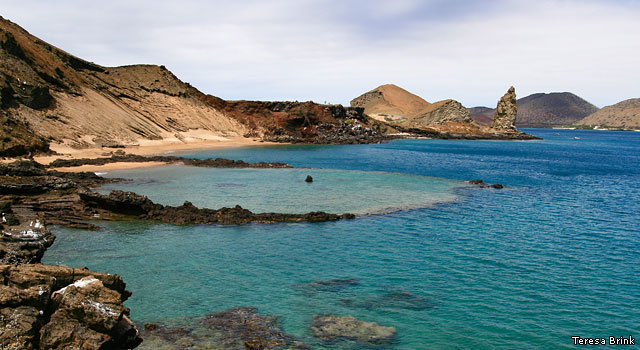Escalera :: Bartolomé Island

The top of this hill is about 115 m and the route is performed on a path of 795 meters.
No one knows the exact age of this island, but by its geological composition and general characteristics it is quite young. The few plants found on the island are called pioneers because they are the first to arrive and settle. E.g. Tiquilia nesiotes, Tiquilia fusca and Chamaesyce spp.
East of the summit are spatter cones, consisting of thick lava droplets. These cones are parasites because they did not form from the main vent. To the west lie tuff cones (volcanic ash sediment) and their eroded remnants. The Tower or Pinnacle is part of a tuff cone.
The main attraction is the geological interpretation that can be given to this site.
The geological features and soils here are very delicate. Due to wear caused by use, the GNPS has built stairs to avoid further erosion and better manage visitors. In no way should one be allowed to walk outside of the stairs.
Galapagos Islands Tours Galapagos Islands Cruises Galapagos Islands Information
There are two beaches that are visitor areas and are connected by a path. The beach to the south is beautiful for walks and to observe stingrays and sharks, but swimming is prohibited here. The north beach is one of the best sites for snorkeling; in addition, most of the year it's mild and is an ideal place for swimming. Sometimes you can see penguins fishing.
![]()
A small colony of penguins, Spheniscus mendiculus, breeds in the small bay. Bartolomé is one of the best places to see them. (For more information about penguins see Elizabeth Bay)
Visitors are not permitted to get too close to penguins when they are resting on the ground. It is better to see them and photograph them from the panga. Insist that your passengers stay only in the beach area. It is forbidden to walk on the rocks on either sides of the bay; penguins that were lying hidden in the lava and hollows are easily disturbed. Also request that visitors not put any clothes on the bushes.
In 2005 the presence of goats was completely eliminated on Santiago Island, this is thanks to the creation of a bi-institutional project between the Galapagos National Park Service and the Charles Darwin Foundation called Project Isabela.
The introduced black rat is causing huge disturbances in some populations of native animals, including tortoises in Pinzón and the Galapagos Petrel (pata pegada) in Santa Cruz. Typically, where there are black rats, the endemic rat disappears, either by competition or by a virus whose carrier is the introduced rat. However, both species (endemic and introduced) have been found in Santiago (Dowler, 1997). In 1976, personnel from the Park and the Station removed all the black rats in Bartholomé, using accepted traps and selective poison. However, it is considered that these methods are not applicable to larger areas.
![]()
Special Indications
-
Stay within the paths. The geological features and soils here are very delicate. Due to wear caused by use, the GNPS has built stairs to avoid further erosion and better manage visitors.
-
At the top of the island is a marine lighthouse, do not go up to this site because the top is a volcanic vent whose cover is extremely fragile and could collapse.
-
Do not get too close to penguins when they are resting on the ground because it can alter their natural behavior. It is better to see them and photograph them from the panga. Stay in the beach area.
When you are climbing to the summit and there is more than one group, wait a reasonable time to be kept separate from other groups.
![]()
Galapagos Islands Tours Galapagos Islands Cruises Galapagos Islands Information

